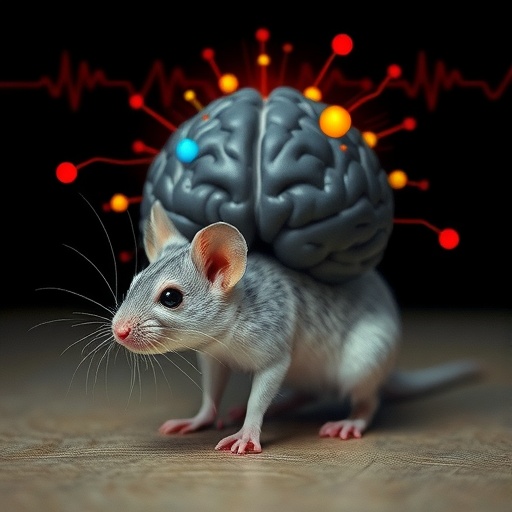In the rapidly evolving field of neuroscience, the interplay between pharmacological agents and brain functionality is undergoing meticulous investigation. A groundbreaking study led by researchers U. Jasinskyte and R. Guzulaitis has shed light on how certain pharmacological interventions can disrupt brain rhythms, particularly focusing on male and female mice as a model for understanding schizophrenia. This research not only aims to broaden our comprehension of the neurobiological underpinnings of schizophrenia but also emphasizes the crucial importance of sex differences in psychiatric research.
Schizophrenia, a complex and multifaceted mental disorder, affects approximately 1% of the global population. The symptoms, which include hallucinations, delusions, and impaired cognitive function, have long been associated with dysregulated neural oscillations—essentially, the brain’s electrical activity patterns. Such dysregulation can significantly impair communication between various brain regions, leading to the characteristic symptoms of the disorder. By examining how pharmacological agents can induce these disruptions in a controlled experimental setting, the study provides valuable insights that could pave the way for more targeted treatment strategies.
The researchers employed a variety of pharmacological agents known to mimic aspects of schizophrenia in laboratory mice. These agents were chosen based on their efficacy in previous studies that demonstrated their ability to elicit psychotic-like symptoms. By administering these compounds to both male and female mice, the team was able to monitor the resultant changes in brain activity, specifically focusing on the rhythmic patterns that are pivotal for cognitive processes. The implications of their findings suggest potential pathways for developing new therapeutic interventions aimed not only at alleviating the symptoms of schizophrenia but also at restoring normal brain function.
Data collection methods in this research were meticulously designed to ensure accuracy and reproducibility. The researchers utilized electroencephalography (EEG) to record the electrical activity of the brains of both male and female mice throughout the experiments. This technique allowed for a real-time view of the brain’s oscillatory behavior, revealing distinct patterns emerging from the pharmacological manipulation. Notably, the results indicated that both sexes exhibited significant alterations in their brain rhythm patterns, but these changes were found to exhibit variability that could be traced back to biological sex differences.
The study’s findings align with a growing body of literature highlighting the necessity of examining sex as a biological variable in neuroscience. Traditional research has often overlooked these differences, conducting experiments predominantly on male subjects. However, as this study illustrates, female mice may respond differently to pharmacological agents, thus underscoring the importance of inclusivity when designing and interpreting research studies. The differential responses observed provide a compelling argument for the need to tailor schizophrenia interventions based on sex-specific biological mechanisms.
Furthermore, the implications of these findings extend beyond schizophrenia research to encompass a broader understanding of brain function. Dysregulated brain rhythms are implicated in various neurological and psychiatric disorders, suggesting that the principles uncovered in this study may have wider applicability. The ability to manipulate brain oscillations through pharmacological means could emerge as a novel therapeutic avenue not just for schizophrenia but for a plethora of conditions associated with abnormal neural activity, including ADHD, depression, and even forms of epilepsy.
In a contemporary context where mental health resources are increasingly prioritized, understanding the neurobiological bases for psychiatric disorders is vital. With this research, Jasinskyte and Guzulaitis contribute to an essential dialogue regarding the treatment of schizophrenia, fostering a narrative that emphasizes the need for more granular and comprehensive approaches. By elucidating the underlying mechanisms through which pharmacological agents disrupt brain rhythms, their work underscores the necessity for researchers and clinicians to adopt a multidimensional view when addressing psychiatric illnesses.
As the study progresses towards practical applications, it raises questions about future research directions. What methodologies can be utilized to further explore the mechanisms behind the observed disruptions in brain rhythms? How can these methodologies be expanded upon to ensure they encompass the complexities of human neurobiology? With continued exploration of these issues, future research may be able to harness pharmacological tools not only to probe the intricacies of the brain but also to develop innovative therapies that can be tailored to individual patients based on biological sex.
The ongoing dialogue around mental health perpetuates the necessity for robust investment in research. As societal stigma diminishes, there is an imperative for advancing our understanding of conditions like schizophrenia. Efforts such as those initiated in this study provide a solid foundation for future inquiries that could potentially lead to groundbreaking treatments. By meticulously studying how pharmacological interventions can modulate neural oscillations, researchers are ideally positioned to make impactful contributions that could significantly improve the quality of life for those affected by schizophrenia.
In summary, the work conducted by U. Jasinskyte and R. Guzulaitis represents a significant advancement in our understanding of the interplay between pharmacology and brain function concerning schizophrenia. Their insights broaden the horizons of potential therapeutic avenues while emphasizing sex differences integral to mental health research. As investigations continue to unfold, the hope is for a future where treatments are not only effective but also personalized, leading to improved outcomes for all individuals afflicted by mental health disorders.
Subject of Research: Pharmacological disruption of brain rhythms related to schizophrenia in male and female mice.
Article Title: Disruption of brain rhythms in a pharmacological model of schizophrenia in male and female mice.
Article References:
Jasinskyte, U., Guzulaitis, R. Disruption of brain rhythms in a pharmacological model of schizophrenia in male and female mice.
Biol Sex Differ 16, 94 (2025). https://doi.org/10.1186/s13293-025-00773-w
Image Credits: AI Generated
DOI: https://doi.org/10.1186/s13293-025-00773-w
Keywords: schizophrenia, brain rhythms, pharmacology, male and female mice, sex differences, neurobiology, mental health.
Tags: brain rhythm disruptioncognitive function impairment in schizophreniaelectrical activity patterns in the brainhallucinations and delusions in mental disordersneural oscillations and schizophrenianeurobiological underpinnings of schizophreniapharmacological agents in psychiatric researchpharmacological interventions in neurosciencepsychotic-like symptoms in laboratory miceschizophrenia model micesex differences in psychiatric researchtargeted treatment strategies for schizophrenia





